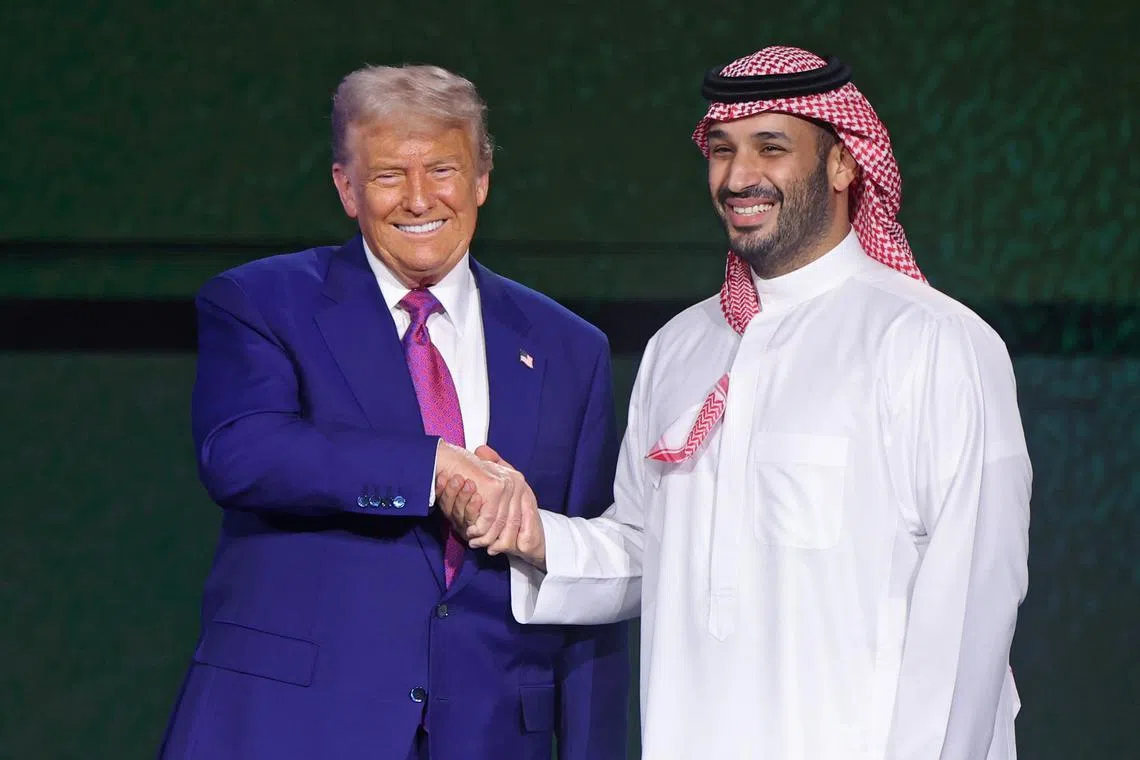US-Saudi $184.5 billion defence deal sparks questions, few answers
Sign up now: Get ST's newsletters delivered to your inbox

US President Donald Trump and Saudi Crown Prince Mohammed bin Salman in Riyadh, Saudi Arabia, on May 13.
PHOTO: EPA-EFE
Follow topic:
The Trump administration called its US$142 billion (S$184.53 billion) defence deal with Saudi Arabia “the largest defence sales agreement in history”.
Critics are not so sure.
The deal, announced as part of US President Donald Trump’s visit to the Middle East this week, appeared ambitious and sweeping, touting purchases linked to the air force and space, missile defence, coastal security and various other upgrades.
But like the broader US$600 billion economic deal that it was a part of, the defence agreement lacked any specifics.
And sceptics of the administration immediately pointed to questions around the numbers.
One is that Saudi Arabia’s entire defence budget in 2025 is US$78 billion, estimated Mr Bruce Riedel, a non-resident senior fellow at the Brookings Institution.
“It’s great publicity – makes it look like this trip was spectacularly successful,” said Mr Riedel, a former senior US intelligence and national security official.
“But the numbers don’t add up.”
The White House, Pentagon and Saudi Embassy did not immediately respond to requests for details of the agreement, such as which systems the kingdom would purchase, terms of the prospective contract and delivery timelines. The State Department referred questions to the White House.
To be sure, Democratic and Republican administrations alike have a long history of re-purposing previous deals into sweeping, headline-grabbing agreements for presidents to sign during trips.
Mr Trump did it before, during his first-term trip to Saudi Arabia in 2017, when he announced the Saudis would spend US$110 billion on US weapons to modernise the kingdom’s military.
That package included deals negotiated under the Obama administration and others that were in the initial stages of a lengthy process requiring congressional approval and negotiations between the buyer and defence contractors.
To date, the 2017 deal has yielded more than US$30 billion in implemented foreign military sales to Saudi Arabia, according to a State Department fact sheet in January.
Another potential hurdle is Saudi Arabia’s ability to afford massive defence purchases amid declining oil prices and considerable obligations at home.
The country has been forced to borrow more, with debt jumping by about US$30 billion to the most on record in the first quarter.
If deals do eventually emerge from the White House and Saudi Arabia, experts will start sorting through what was new and what was old.
Already, there are more than US$129 billion in active military sales to Saudi Arabia from the US, according to the State Department fact sheet.
While the numbers may be fuzzy, they also may not really matter.
What the agreement also does, experts said, is highlight the depth of the US-Saudi partnership.
That is something Crown Prince Mohammed bin Salman will gladly take after several years of uncertainty.
Former president Joe Biden, after all, called him a “pariah” over the killing of Washington Post columnist Jamal Khashoggi and suspended weapons sales to the kingdom.
“A lot of this is about the optics, but the optics matter,” said Mr Brian Katulis, a senior fellow at the Middle East Institute.
“It’s an attempt to send a message of reassurance after several years of uncertainty in the US-Saudi bilateral relationship on defence cooperation.”
The agreement is likely to yield real gains, particularly in the realm of missile defence, where the US has much to offer and Saudi Arabia has significant needs, said Mr Todd Harrison, a senior fellow at the American Enterprise Institute focusing on defence strategy and budgeting.
At a time when some of the US’ traditional allies in Europe may be reluctant to purchase weapons from Washington, Saudi Arabia’s willingness to do so is especially welcome, he said.
Even without specifics, some analysts said the scale and complexity of weapons purchases contemplated by Saudi Arabia could risk compromising Israel’s “qualitative military edge” in the region, which US presidents for decades have committed to maintain.
But Ms Dana Stroul, director of research at the Washington Institute for Near East Policy, said that the categories outlined by the White House have long been part of Saudi Arabia’s military modernisation plans.
Absent more detail about particular weapon systems, they do not raise alarms about qualitative military edge, said Ms Stroul, a former deputy assistant secretary of defence for the Middle East.
The Saudis are committed to pursuing a formal mutual-defence agreement with the US, as well as a civil nuclear programme, “because they don’t trust the US a hundred per cent”, said Dr Yoel Guzansky, head of the Gulf Programme at the Institute for National Security Studies at Tel Aviv University.
Faced with a number of threats and with longstanding doubts about US reliability, the Saudis “will continue to hedge” by de-escalating with Iran and engaging with China and Russia, even as they pursue prizes like the F-35, said Dr Guzansky, a former Israeli national security council official. BLOOMBERG

